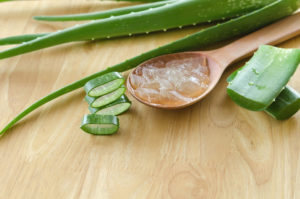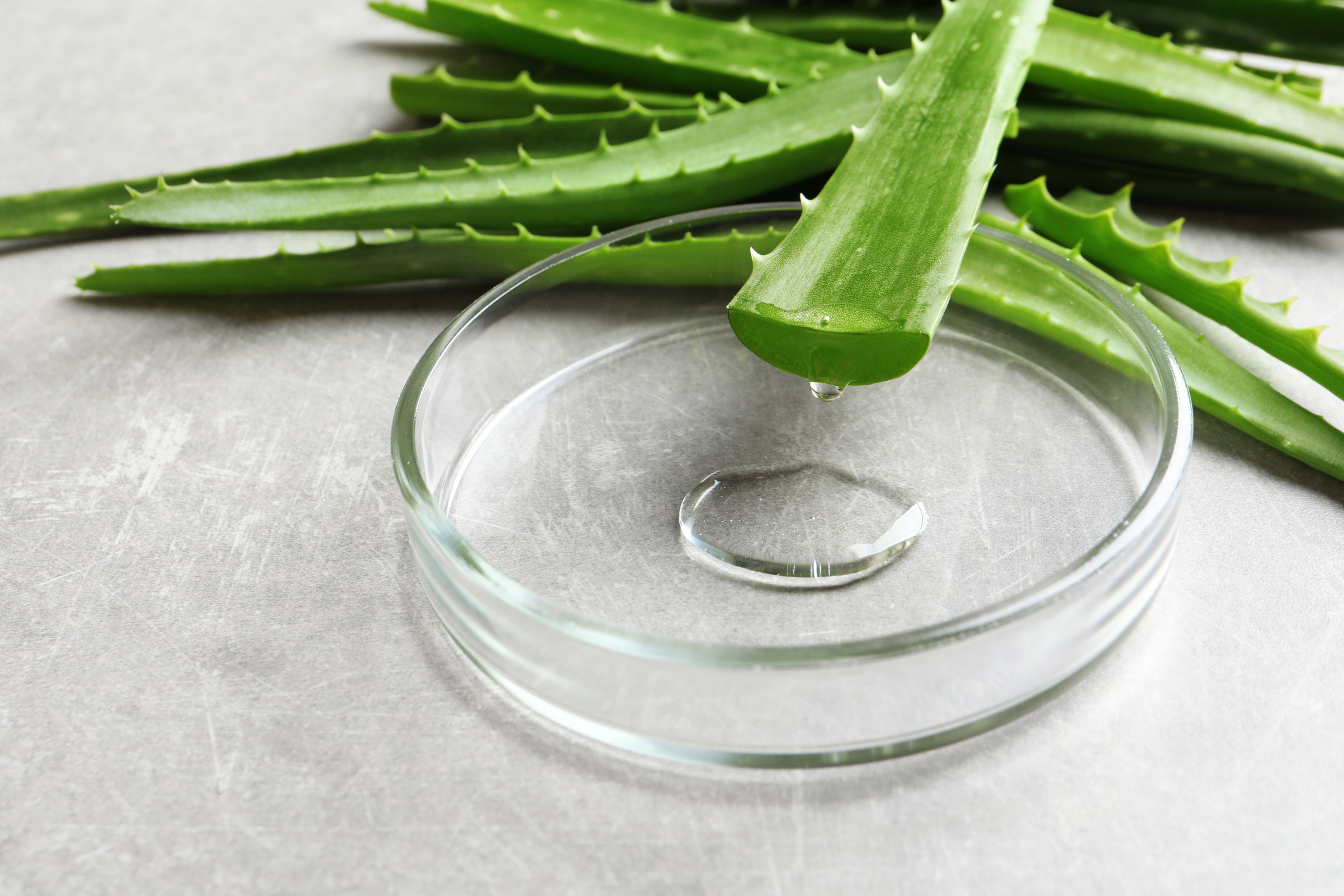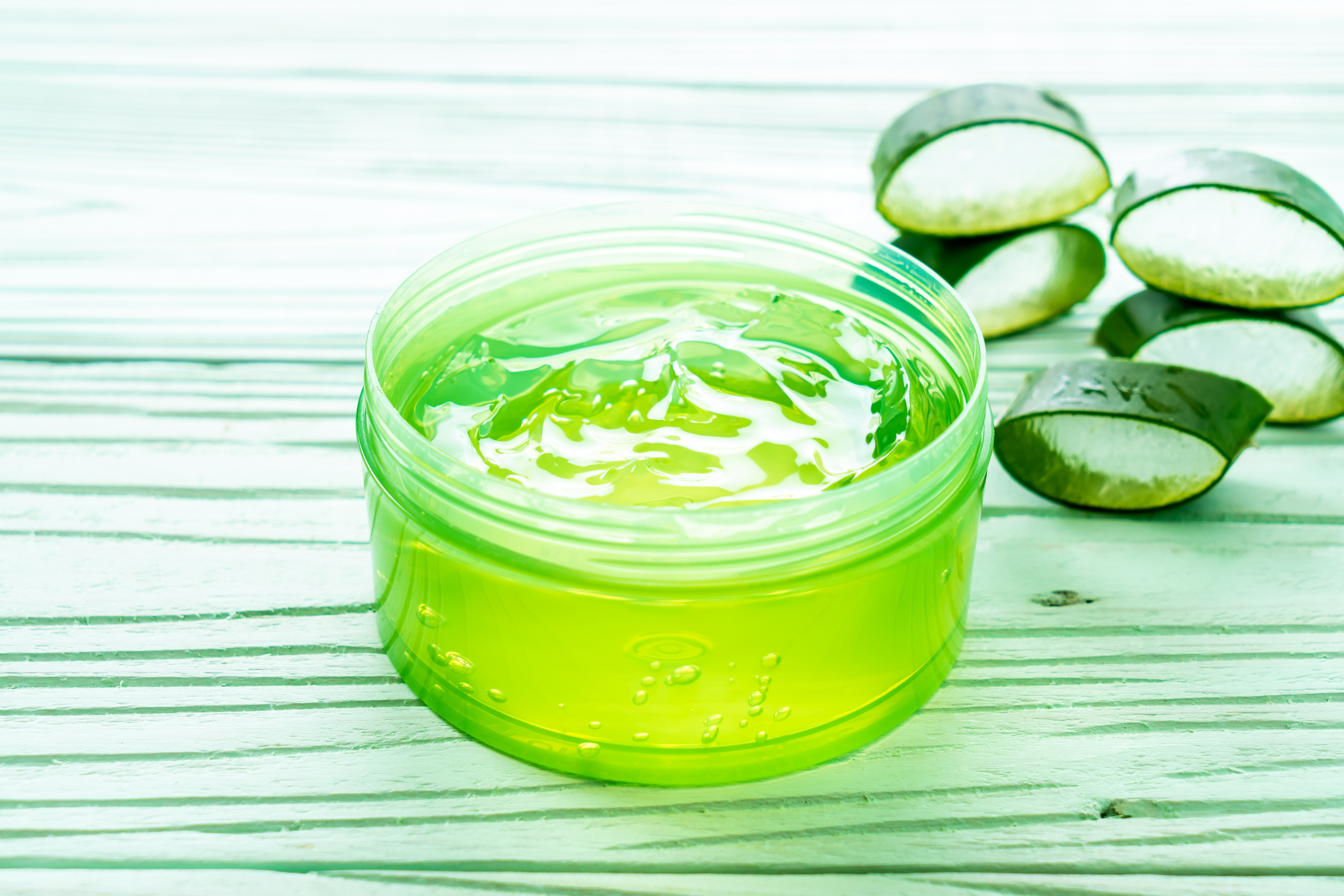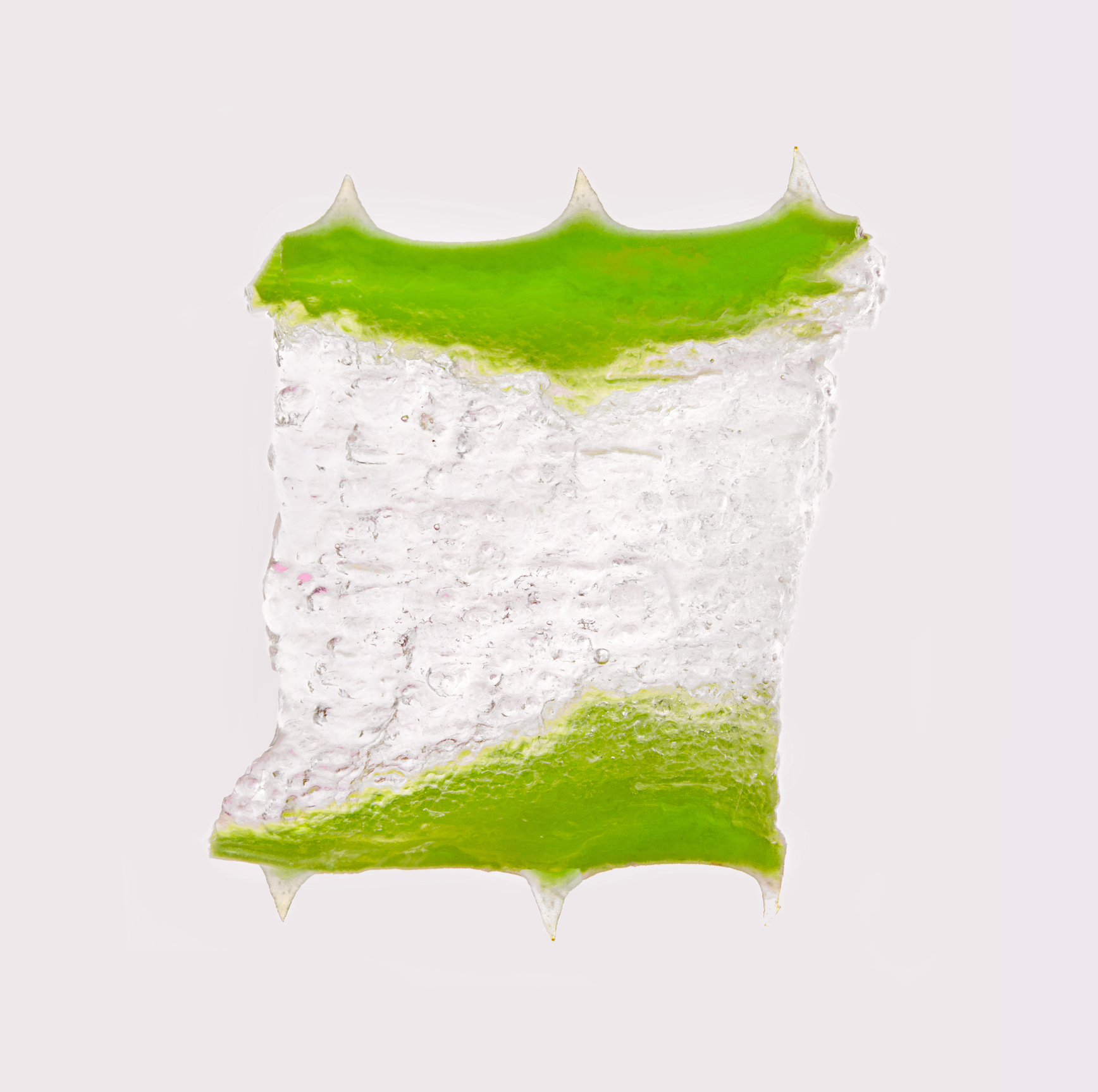If you want to combine aloe vera and essential oils in order to make a natural gel, there are some important things you need to know.
The botanical name, Aloe vera, means “true aloe”, and it has many synonyms. The one you’re mostly likely to find on ingredient lists is Aloe barbadensis – so this is the same plant, not a different one.
 You’ll be hard pressed to find someone who hasn’t heard about this plant, and its wonderful properties, whether for the health of our skin or our digestive system. It’s one of the few evergreen ingredients in skincare – it seems to survive all fads and trends, and it has gradually become a staple in our smoothies too.
You’ll be hard pressed to find someone who hasn’t heard about this plant, and its wonderful properties, whether for the health of our skin or our digestive system. It’s one of the few evergreen ingredients in skincare – it seems to survive all fads and trends, and it has gradually become a staple in our smoothies too.
Gels are a great medium if you’re looking for no grease and great absorption, so aloe vera seems like an obvious choice. However, finding a product that will work with essential oils can be tricky as there are many aloe gels, gellies, jellies, juices and powders, and pure aloe extracts are water-soluble, so won’t easily mix with essential oils.
Food considerations aside, we need to find a way to use aloe in a product that will keep essential oils incorporated – properly dispersed and therefore diluted – while also performing the way we want them to.
In this blogpost, I’m going to explain some of the issues with different products, and tell you how to find the right aloe for what you need.
Why does it matter?
Choosing the right medium for your essential oils is a matter of safety – both in terms of essential oil content, and the end product.
Firstly, you need to make sure what you are using will hold essential oils dispersed evenly so you end up with proper dilution as well as homogenous dispersion. This means you will get a consistent concentration of essential oil with every application.
Secondly, you need a stable product – one that will not separate, and will not grow harmful microbes.
You can either buy an aloe-based gel that has been formulated specifically to allow the addition of essential oils (and ideally is advertised as such by the seller) or you can make your own formulation. And in each case, your choices will be different.
A side note on formulation
Once you go beyond using fatty oils as the medium for your essential oils, you are entering the world of product formulation. This means you need to keep a few more things in mind than just the proper dilution range of essential oils – one of which is warding off unwanted visitors.
 If you’re making a product that contains water, whether it’s an emulsion, a gel or a spray, you need to make sure to either use it within 24 hours, or use an appropriate preservative. Preserving aqueous (water-based) products is a whole subject that is beyond the scope of this article, and the one you choose depends on many factors. Generally speaking you should be able to rely on broad-spectrum preservatives, but for any product that is for sale, rigorous testing needs to be carried out to verify safety and stability.
If you’re making a product that contains water, whether it’s an emulsion, a gel or a spray, you need to make sure to either use it within 24 hours, or use an appropriate preservative. Preserving aqueous (water-based) products is a whole subject that is beyond the scope of this article, and the one you choose depends on many factors. Generally speaking you should be able to rely on broad-spectrum preservatives, but for any product that is for sale, rigorous testing needs to be carried out to verify safety and stability.
Aloe vera is an aqueous extract, which means preservation will be necessary. On top of that, because we want to marry aloe vera with essential oils which are not water-soluble, we will will need to include a solubilizing agent that will enable these two to combine.
If you’ve ever dabbled in formulation, you will know that creating a stable product that contains both water-based and oil-based ingredients is a balancing act that can be thrown off by a slight change in composition. Unless a ready-made gel is made to stay stable even with essential oils added to it, adding them can cause the product to “fail”, resulting in ingredient separation and/or colonization by unwanted bacteria and molds.
Similarly, if you have a formula you want to create and it calls for aloe vera gel, you want to make sure this ingredients will not throw it off – in this case, go as simple as you can. Just let the ingredient lists be your guide.
Always look at the label
There are many names of aloe vera products, and you will find some of them in the isles in your local pharmacy, drug store or supermarket. If you Google images for “aloe vera gel”, you will mostly find slightly green transparent gels with some spiky leaves on the label to remind you that they contain aloe. However, what comes directly from the plant is colorless, odorless, and fairly liquid. So those aloe vera gels with green, blue or even pink(!) colors have colorants in them, and their viscosity is due to added thickeners. 
Thickeners are generally fine, but you do want to look at the ingredients list to make sure the product you’re getting does not contain anything you don’t want it to contain. And as you see in the sample product ingredients list below, the number of ingredients can run quite long, especially with “gels” or “jellies” intended to be used on the body.
Depending on your personal preference you can use aloe-based gels that also contain (synthetic) carbomer or other solubilizers, which may possibly remain stable, but it’s always best to ask the manufacturer.
If you’re looking for a more natural but ready-made product for your oils, you will want it to contain a natural thickener such as guar gum, xanthan gum, or agar agar, and a preservative system such as vitamin C and potassium sorbate.
Again, do ask the manufacturer how much essential oil you can safely add to the product, and avoid already perfumed products as they could interfere with your essential oil fragrance and potentially their therapeutic benefits.
In a supermarket or drug store, you will generally find simpler ingredient lists for aloe juices and gels in the food isles (mostly just aloe vera plus preservative). These will be very useful if you plan to make your own formula, as you won’t be introducing a whole plethora of ingredients. Just avoid juices/gels that contain flavorings or sweeteners.
Aloe vera straight from the plant
Even if you don’t live in the kind of tropical or subtropical climate where the Aloe plants thrive, chances are you have seen one somewhere. The thick tongue-like spiky leaves of this sturdy succulent are quite recognizable, and so you may want to harvest your gel directly. (Just make sure you don’t mistake Aloe vera for another succulent such as Yucca or Agave, which can both be toxic if eaten raw, and neither will impart the health benefits of Aloe!)
So yes it can be done, just be sure to follow safe procedures. Once you get your fresh leaves, drain any resin from them first by letting them stand in a jar for some time. Then peel one side of the leaf with a vegetable peeler and carefully scoop the translucent gel-like inside of the leaf with a spoon, making sure to not take any skin. Whizz the substance in your blender to make it smooth and homogenous – and voila! 
The resulting substance is perhaps a bit runnier than you’d expect, and definitely not green as those stock photos would have you believe. It should be translucent, or slightly opaque and colorless. This gel is unpreserved, and will either need to be used immediately or treated with a suitable preservative.
Another option for a one-ingredient aloe is to use aloe vera powder and reconstitute it following the manufacturer’s instructions. Both the freshly harvested and reconstituted aloe vera will be good ingredients for your own formulas, but will not hold essential oils on their own.
What do I do then?
Depending on whether you want to have a ready-made medium to which you just add essential oils, or whether you want aloe vera to incorporate in your own aromatic skincare, your choices will be different. In the first case, look for unperfumed aloe vera products (usually gels, or jellies) that are made and marketed for use with essential oils. You will find these sold by some essential oil suppliers. Never hesitate to ask the seller for more details on how to use their product with essential oils.
If you are formulating a gel with aloe, either look in the food isles for aloe products with shorter ingredients lists, or make your own from fresh aloe. Aloe vera is a great addition to any emulsion or gel formula as it acts as a natural pH balancer and is very well tolerated. Just make sure your product is adequately preserved and includes solubilizer to disperse your essential oils evenly.
Examples of Aloe Gel product names and ingredient lists found online
“Aloe Vera Gel”
Aloe Vera, Citric acid (pH stabilizer), potassium sorbate
“Aloe Vera Gel”
Aloe barbadensis, potassium sorbate (antioxidant), citric acid (preservative), and xanthan gum (thickener)
“Aloe Vera Gel”
Certified Organic Aloe Vera (99%), Seaweed extract (natural thickener), Citric acid (to stabilize pH), Ascorbic acid (Vitamin C), Potassium sorbate (to prevent mold).
“Aloe Vera Gel”
Water, Aloe Barbadensis Leaf Juice, Glycerin, Polysorbate 20, Triethanolamine, Carbomer, Diazolidinyl Urea, Iodopropynyl Butylcarbamate, Propylene Glycol, Benzophenone-4, Blue 1, Yellow 5, Fragrance.
“Pure Aloe Vera Gel”
Organic Aloe Barbadensis Leaf Juice, Carbomer, 1,2-Hexanediol, Hydroxyacetophenone, Triethanolamine, Disodium EDTA
“100% Pure Aloe Vera Gel”
Aloe Vera Gel, Triethanolamine, Tocopheryl Acetate, Carbomer 940, Tetrasodium EDTA, DMDM Hydantoin, Diazolidinyl Urea.
“Aloe Vera Jelly”
Aloe Vera, Honey, Sugar, Citric Acid, Water
“Aloe Vera Gelly”
Real Aloe Vera*, Purified Water, Irish Moss, Xanthan Gum, Citric Acid, Sodium Benzoate, Potassium Sorbate
“99% Aloe Vera gelly”
Organic aloe vera barbadensis leaf juice (gel), carbomer (thickener), certified organic aloe vera juice (gel) concentrate, organic aloe vera barbadensis leaf polysaccharides (aloesorb), tocopheryl acetate (vitamin E), retinyl palmitate (vitamin A), ascorbic acid (vitamin C), disodium EDTA (preservatives), caprylyl glycol (emollient), phenoxyethanol (preservative), sorbic acid (preservative).


Thank you for this thorough explanation. It it very useful and helpful.
Hi there. I have the aloe vera succulents and want to make a balm i was thinking to combine aloevera with beeswax and cocunut oil. Some drop lavender and tea tree . How can I make it last long. Like increase shelf life. Do you maybe have a good recipe? New to the natural indistry. Just want to go more natural for my family. Your feedback would be much appreciated. Kind regards
Hi Sonamarie!
What you’re desciribing would be an emulsion (lotion/cream) using your aloe plant, which is possible. You would need to process the leaves in a safe way, and there are many good instructional videos on how to do that. And then to combine it with beeswax and coconut oil you’ll need to add a suitable emulsifier, and a preservative system as there will be water in your product.
We have a series of courses that are designed to build a solid foundation for creating your own products, if you’d like to explore that option.